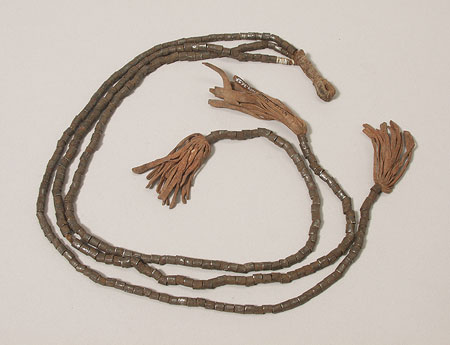Accession Number:
1884.76.27
Country:
?Sudan
Region:
[White Nile]
Date Made:
Before 1874
Materials:
Animal Leather Skin , Iron Metal , Ostrich Eggshell Bird
Process:
Strung , Threaded , Hammered , Plaited , Twisted , Dyed
Dimensions:
L = 578 mm, W loop = 7.8 mm, Diam iron bead = 4 mm, L iron bead = 5 mm, Diam white bead = 3.8 mm, Th white bead = 1 mm [RTS 29/3/2004].
Weight:
91.4 g
Other Owners:
Pitt Rivers sent this object to Bethnal Green Museum for display, as part of the first batch of objects sent there, probably in 1874. This object was listed in the Delivery Catalogue as having been transferred from South Kensington Museum in 1884
PRM Source:
Augustus Henry Lane Fox Pitt Rivers founding collection
Acquired:
Donated 1884
Collected Date:
Prior to 1874
Description:
Ornament composed of three strings made from twisted fibre, the tops ends of which have been bound inside several narrow hide strips plaited together and bent over into a loop at the top; this has been made in two sections which have hide stitches binding them together.
Each string has several beads threaded onto it.
The first string is made up of 8 white disc beads, possibly ostrich eggshell, a similar disc bead in an unknown light gray material, then 96 short cylindrical beads, each shaped from sheet iron with a seam down one edge.
The second string is made up of 101 iron beads, and the third of 99 similar beads.
Each string ends in a loop, through which a number of hide strips have been fastened to make up tassels with 11, 14 and 18 pieces respectively.
These tassels are a reddish brown colour (Pantone 1615C) and have probably been dyed.
The total length of the object is 578 mm; the loop at the top has a width of 7.8 mm, the white beads have a diameter of 3.8 mm and a thickness of 1 mm, and the iron beads have an average diameter of 4 mm and length of 5 mm.
The object weighs 91.4 grams.
The original collector of this object is not known. It was displayed in the Bethnal Green Museum, probably in 1974, then later displayed in the South Kensington Museum before being transferred to form part of the founding collection of the Pitt Rivers Museum in 1884. The provenance is given only generically as ‘the White Nile’, which was probably used in a very generic sense.
Two similar strings of iron beads with leather tassels were collected by Mansfield Parkyns between 1842 and 1850; these are also thought to have come from the 'White Nile' (1896.5.2-3).
Schweinfurth discusses the role that early iron beads had to play in the Southern Sudan, amongst groups like the Jur Luo: 'iron beads or perforated little cylinders of iron… were earlier in use than glass beads… In the Soudan these string of beads were principally made at Wandala, and Barth has specially noticed them at Marhi. Every tribe which I visited in proceeding inland from the Gazelle I found to retain the preference for beads made of iron (G. Schweinfurth, 1873, In the Heart of Africa Vol. I, 203-4).
Rachael Sparks 29/9/2005.
The original collector of this object is not known. It was displayed in the Bethnal Green Museum, probably in 1974, then later displayed in the South Kensington Museum before being transferred to form part of the founding collection of the Pitt Rivers Museum in 1884. The provenance is given only generically as ‘the White Nile’, which was probably used in a very generic sense.
Two similar strings of iron beads with leather tassels were collected by Mansfield Parkyns between 1842 and 1850; these are also thought to have come from the 'White Nile' (1896.5.2-3).
Schweinfurth discusses the role that early iron beads had to play in the Southern Sudan, amongst groups like the Jur Luo: 'iron beads or perforated little cylinders of iron… were earlier in use than glass beads… In the Soudan these string of beads were principally made at Wandala, and Barth has specially noticed them at Marhi. Every tribe which I visited in proceeding inland from the Gazelle I found to retain the preference for beads made of iron (G. Schweinfurth, 1873, In the Heart of Africa Vol. I, 203-4).
Rachael Sparks 29/9/2005.
Primary Documentation:
Accession Book IV entry
[p.
167]
-
[insert] 1884.76 [end insert]
PERSONAL ORNAMENTS BEAD-WORK
of GLASS, SHELL & BEADS [insert] 27 [end insert] - Ornament of three strands of leather strung with cylindrical iron beads.
W.
NILE.
Black 1506 [Note that this is wrong - AP].
Black Book Entry [p. 60] - 1508. Necklace, iron beads, C. Africa. [insert] 1884.76.27 [end insert].
Delivery Catalogue II entry [p. 271] - 3 strings of iron beads - White Nile. 1508. Case 8, [screen?] 325.
Card Catalogue Entry - There is no further information on the catalogue card [RTS 30/1/2004].
Pitt Rivers Museum label - Ornament made of 3 strands of leather strung with iron beads. WHITE NILE C. AFRICA. P.R.coll. black [1506] [El.B 'DCF 2004-2006 What's Upstairs?' 22/6/2005]
Written on object - WHITE NILE [El.B 'DCF 2004-2006 What's Upstairs?' 22/6/2005]
Black Book Entry [p. 60] - 1508. Necklace, iron beads, C. Africa. [insert] 1884.76.27 [end insert].
Delivery Catalogue II entry [p. 271] - 3 strings of iron beads - White Nile. 1508. Case 8, [screen?] 325.
Card Catalogue Entry - There is no further information on the catalogue card [RTS 30/1/2004].
Pitt Rivers Museum label - Ornament made of 3 strands of leather strung with iron beads. WHITE NILE C. AFRICA. P.R.coll. black [1506] [El.B 'DCF 2004-2006 What's Upstairs?' 22/6/2005]
Written on object - WHITE NILE [El.B 'DCF 2004-2006 What's Upstairs?' 22/6/2005]
Display History:
Displayed in Bethnal Green and South Kensington Museums (V&A) [AP].



